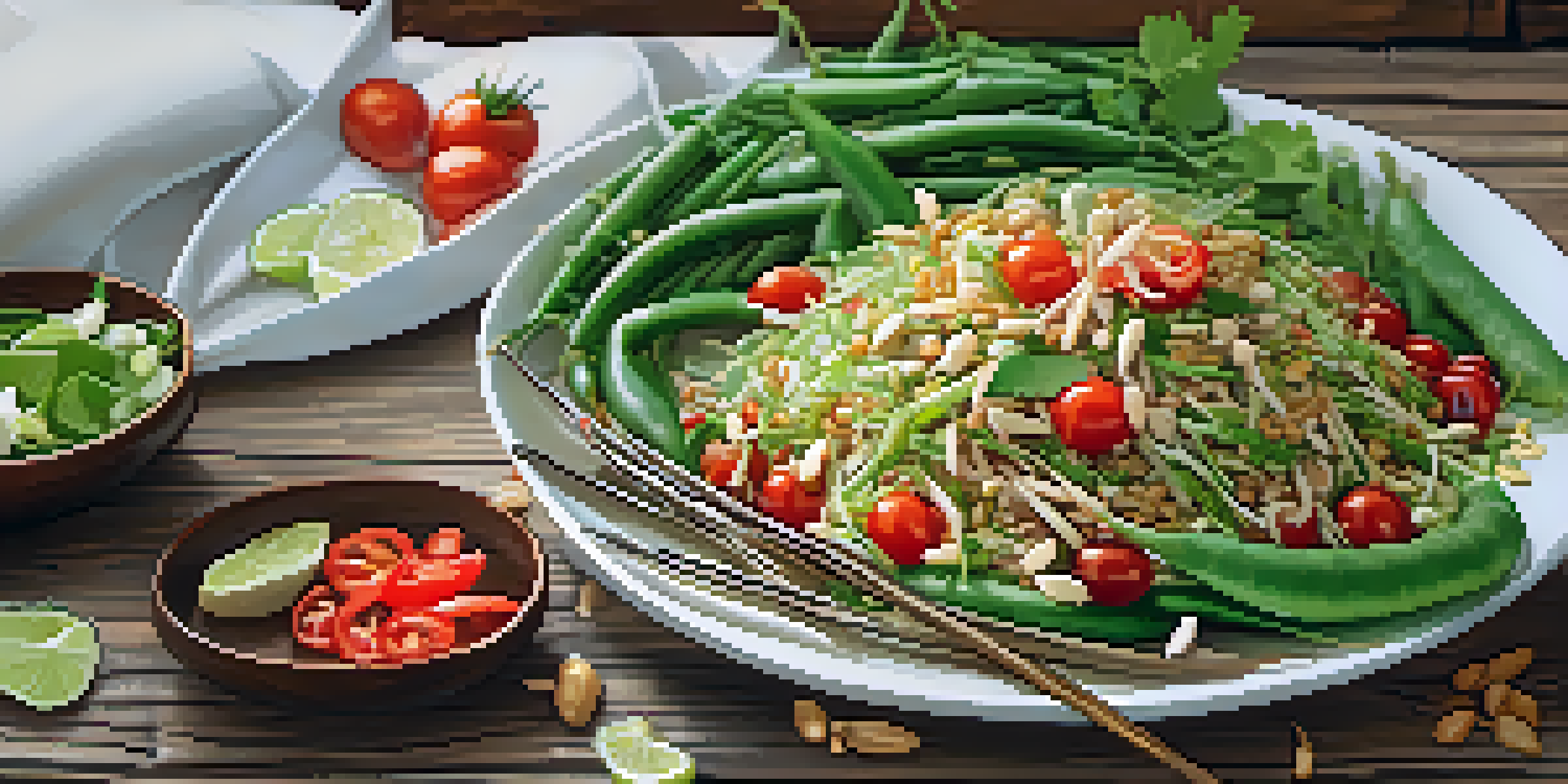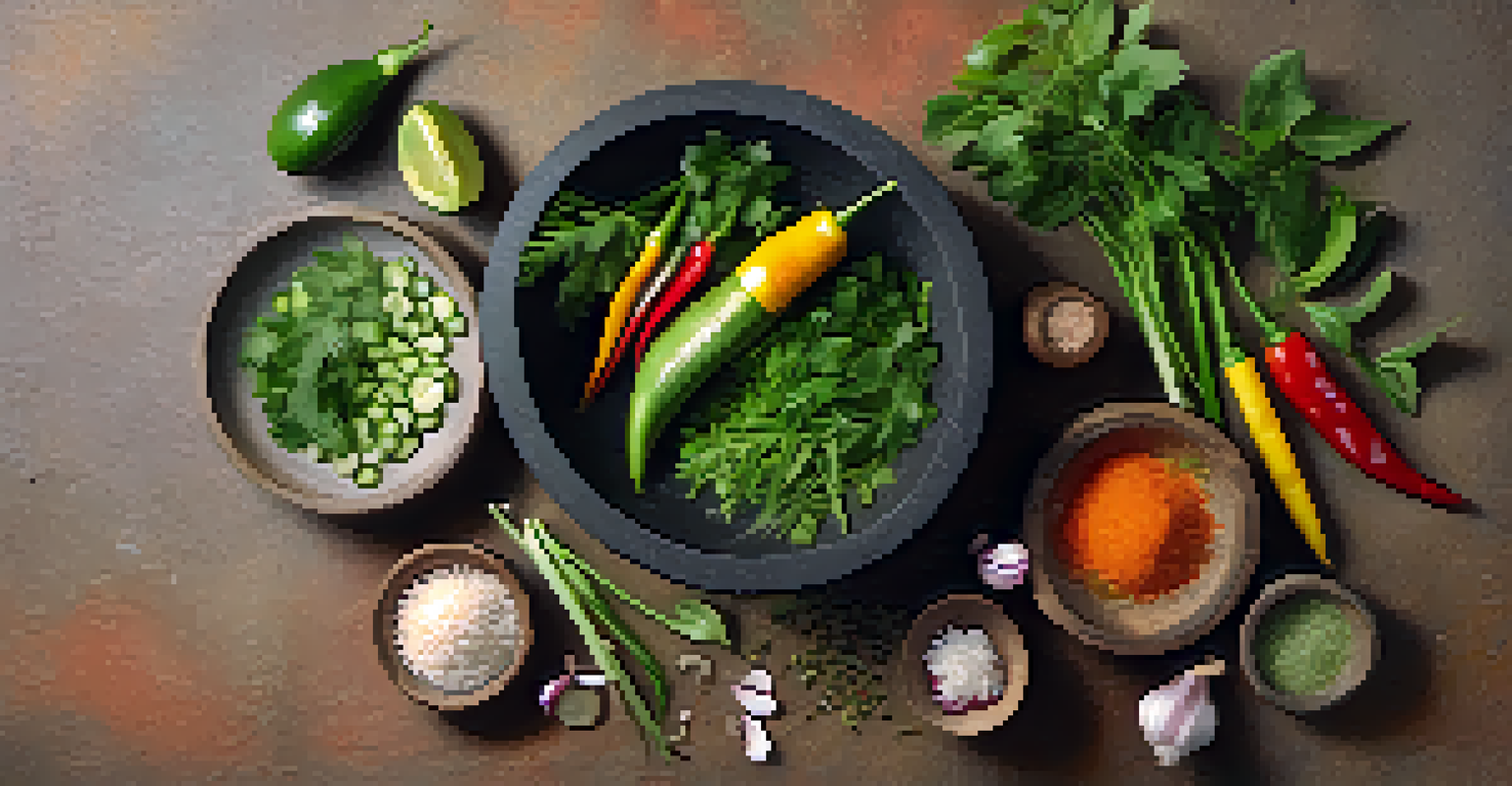Som Tum: The Story Behind Thailand's Spicy Papaya Salad

The Origins of Som Tum: A Thai Culinary Treasure
Som Tum, known as spicy papaya salad, hails from northeastern Thailand, particularly the Isaan region. It’s a dish that carries with it the story of local ingredients and the ingenuity of its people. Traditionally, Som Tum was made by the rural communities utilizing fresh papayas found in their gardens, showcasing how simple ingredients can create something extraordinary.
Food is our common ground, a universal experience.
The dish's popularity soared beyond Isaan, finding its way into street food stalls and fine dining restaurants across Thailand and around the world. This migration of flavor illustrates the adaptability of Thai cuisine, where each region’s specialty resonates with both locals and visitors alike. Through Som Tum, one can taste the very essence of Thai culture, rich in history and flavor.
Today, Som Tum represents more than just a meal; it’s a symbol of Thai identity and pride. Each bite tells a story of the land, the people, and their connection to food, making it a beloved dish not just in Thailand but globally.
Key Ingredients: Unpacking the Flavor Profile
At its core, Som Tum features shredded green papaya, which gives the dish its distinct crunch and refreshing taste. However, what truly sets Som Tum apart are the bold flavors that come from a mix of ingredients like lime juice, fish sauce, garlic, and chilies. This combination creates a balance of spicy, sour, salty, and sweet that can tantalize any palate.

Other common additions include tomatoes, long green beans, and peanuts, which contribute additional texture and flavor. Each ingredient plays a role in the overall experience, creating a dish that is vibrant and complex yet simple to prepare. The use of a mortar and pestle to mix the ingredients further enhances the flavors, allowing them to meld beautifully.
Health Benefits of Som Tum
Packed with vitamins and low in calories, Som Tum is a nutritious dish that promotes overall well-being.
The beauty of Som Tum lies in its versatility; you can customize it to your liking by adjusting the level of spice or adding proteins like shrimp or chicken. This adaptability makes it a favorite dish for many, as it can cater to different tastes and dietary preferences.
Cultural Significance: More Than Just a Dish
Som Tum is not merely food; it’s woven into the fabric of Thai life. Often enjoyed as a communal dish, it reflects the importance of sharing meals with family and friends, enhancing social bonds. In many Thai households, preparing Som Tum together can become a cherished activity, filled with laughter and conversation.
Cooking is like love; it should be entered into with abandon or not at all.
This salad also plays a role during special occasions and festivals, symbolizing togetherness and celebration. For instance, during Songkran, the Thai New Year, families often gather to make Som Tum among other traditional dishes, marking the occasion with joy and festivity. It's a reminder of how food can bring people together, transcending differences.
Moreover, Som Tum has been recognized as part of Thailand's cultural heritage, embodying the country’s agricultural practices and culinary techniques. This recognition highlights the importance of preserving traditional recipes and cooking methods for future generations.
The Health Benefits of Som Tum: A Nutritional Powerhouse
Beyond its delicious taste, Som Tum is packed with health benefits, making it a smart choice for those looking to eat well. The primary ingredient, green papaya, is rich in vitamins A and C and is known for its digestive benefits. This makes Som Tum not just a flavorful dish but also a nutritious option for a balanced diet.
The salad is low in calories, which is appealing for those watching their weight, yet it’s high in fiber, promoting gut health and satiety. The inclusion of fresh vegetables and herbs further boosts the nutritional profile, providing essential nutrients and antioxidants that support overall well-being.
Versatile and Adaptable Dish
Som Tum's ability to be customized with various ingredients makes it a favorite among diverse palates.
Additionally, the use of ingredients like lime and garlic can offer various health benefits, including improved immunity and cardiovascular health. With Som Tum, you can indulge in a vibrant meal that nourishes both the body and the soul.
How to Make Authentic Som Tum at Home
Making Som Tum at home is easier than you might think! All you need are fresh ingredients, a mortar and pestle, and a willingness to experiment with flavors. Start by peeling and shredding green papaya, then add in chopped tomatoes, green beans, and peanuts to create a colorful base.
Next comes the fun part: mixing the flavors! In the mortar, pound garlic and chilies together, then add fish sauce and lime juice for that signature tangy kick. Combine everything in a bowl, toss well, and adjust the seasoning to your taste. The beauty of Som Tum lies in its adaptability, so feel free to make it your own.
Serve your Som Tum chilled alongside grilled meats or sticky rice for a complete meal. With each bite, you’ll experience the taste of Thailand right in your own kitchen!
Som Tum Variations: Exploring Regional Twists
While the classic Som Tum is beloved, it's fascinating to see how different regions of Thailand put their own spin on this dish. For example, in the central region, you might find Som Tum with a sweeter profile, incorporating sugar or even fruits like mango. This variation showcases the diversity of flavors found across the country.
In the southern part of Thailand, seafood is often added to Som Tum, giving it a unique twist that highlights the region’s access to fresh fish and shellfish. This not only enhances the flavor but also adds a delightful texture, making it a favorite among seafood lovers.
Som Tum: A Thai Culinary Icon
Originating from northeastern Thailand, Som Tum represents the rich history and cultural significance of Thai cuisine.
These regional variations are a testament to the creativity and adaptability of Thai cuisine, allowing Som Tum to evolve while still honoring its roots. Whether you prefer it spicy, sweet, or seafood-laden, there’s a Som Tum for everyone.
Conclusion: Savoring the Som Tum Experience
In conclusion, Som Tum is much more than a salad; it’s a celebration of Thai culture, community, and flavor. Its rich history and diverse variations make it a dish that continues to delight people around the world. Whether enjoyed on a busy street corner in Thailand or made at home, each serving of Som Tum offers a taste of tradition and a burst of flavor.
As you explore this iconic dish, remember that it represents the heart of Thai cuisine—simple yet profoundly satisfying. The combination of fresh ingredients and bold flavors is a reminder of how food can connect us to our roots and to each other.

So, the next time you savor a bowl of Som Tum, take a moment to appreciate the journey it has taken from the gardens of Isaan to your plate. Embrace the experience, and let the flavors transport you to the vibrant streets of Thailand.